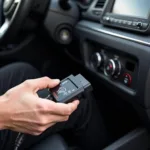The Foxwell NT301 OBD2 scanner is a powerful and affordable tool that can help you diagnose and troubleshoot problems with your car. Whether you’re a seasoned mechanic or a DIY enthusiast, understanding how to use this scanner can save you time and money on car repairs.
This comprehensive guide will walk you through the ins and outs of using the Foxwell NT301, covering everything from basic connection to interpreting error codes.
Understanding the Foxwell NT301
The Foxwell NT301 is a code reader that connects to your car’s onboard diagnostic system (OBD-II) to retrieve and clear diagnostic trouble codes (DTCs). These codes provide valuable insights into the health of your vehicle’s engine and emissions systems.
Connecting the Foxwell NT301 to Your Car
- Locate your car’s OBD-II port. This port is typically found under the driver’s side dashboard, near the steering column.
- Turn on the ignition. Don’t start the engine yet.
- Plug the Foxwell NT301 into the OBD-II port. You should hear a beep, and the scanner’s screen will light up.
Navigating the Foxwell NT301 Menu
The Foxwell NT301 has a simple and intuitive menu system. You can navigate through the different options using the buttons on the scanner.
- Read Codes: This option retrieves all stored DTCs from your car’s computer.
- Erase Codes: After fixing the underlying issue, you can use this option to clear the DTCs and turn off the check engine light.
- I/M Readiness: This function checks if your car’s emission system is ready for an emissions test.
- Live Data: This allows you to view real-time data from your car’s sensors, such as engine RPM, coolant temperature, and oxygen sensor readings.
Interpreting Diagnostic Trouble Codes (DTCs)
A DTC is a five-character alphanumeric code that represents a specific problem area in your car.
- The first character indicates the system related to the code (e.g., “P” for Powertrain, “B” for Body, “C” for Chassis, “U” for Network).
- The second character specifies whether the code is generic (“0”) or manufacturer-specific (“1”).
- The remaining three characters identify the specific problem within that system.
“For accurate diagnosis, it’s crucial to research the specific DTCs you encounter,” advises John Miller, a seasoned automotive engineer. “Online resources, repair manuals, or a trusted mechanic can provide detailed information about the code and potential solutions.”
Common Foxwell NT301 Error Codes and Their Meanings
Here are a few common DTCs and their possible interpretations:
- P0171: System Too Lean (Bank 1) – This code suggests there’s too much air or not enough fuel in the engine’s air-fuel mixture.
- P0420: Catalyst System Efficiency Below Threshold (Bank 1) – This usually indicates a problem with the catalytic converter.
- P0300: Random/Multiple Cylinder Misfire Detected – This signifies that one or more cylinders in your engine are misfiring.
Conclusion
The Foxwell NT301 OBD2 scanner is an invaluable tool for any car owner. It empowers you to understand your vehicle’s health, diagnose problems, and potentially save on expensive repair costs. By following this guide, you can confidently use the Foxwell NT301 to keep your car running smoothly.
Need further assistance? Our 24/7 support team is here to help! Contact us via WhatsApp: +1(641)206-8880, or Email: [email protected].


